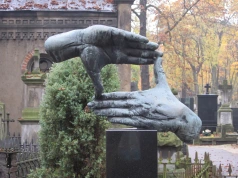• LSO Szymanowski: Violin Concerto no.2
 Karol Szymanowski: Violin Concerto no.2
Karol Szymanowski: Violin Concerto no.2
programme note written for
London, 12 and 19 December 2012
Szymanowski’s close friends from childhood included the pianist Artur Rubinstein and the violinist Paweł Kochański. He dedicated works to them (including the Fourth Symphony to Rubinstein) and both championed his music abroad. The two violin concertos were dedicated to Kochański, who played a major role in working on the technicalities of the solo part. While he had not been able to give the premiere of the First Concerto (1916), Kochański did give the first performance of the Second (1932-33), although it was his last appearance (he died three months later). Szymanowski himself was already ill, and he survived for only four more years.
Like the Fourth Symphony, the Second Violin Concerto is deeply rooted in Polish folk music, especially that of the Tatra Mountain district around Zakopane. They both show a new leanness in Szymanowski’s writing and a concertante approach to the combination of soloist and orchestra. The minor third which underpinned parts of the Symphony is elevated here to a melodic role, part of a folk-like theme unfurled by the soloist. The mood is initially introverted, with the violin in conversation with muted horn and muted trumpet. But as other sections of the orchestra join in, the solo violin picks up the pace and becomes ever more impassioned.
The first climax is a mêlée of layered themes that recalls Szymanowski’s musical persona from his early orchestral works. What becomes apparent in the 30 or so years of his career is that there are certain consistencies that transcend stylistic development, especially his polyphonic textures, his ear for harmony and high lyricism, his ability to create both chamber-like and rich orchestral textures whatever the size of the performing forces. Where the First Violin Concerto is quixotic and ethereal, the Second Violin Concerto is earthy and sinewy. This befits a work which seems to recreate in symphonic form the musical world of Szymanowski’s beloved highlanders, with its open fifth drones and intertwined melodic lines.
After a lyrical episode and a second climax on the main theme, Szymanowski inserts a cadenza. This lies at the heart of the concerto, separating its two movements (like its predecessor, the First Concerto rethinks the structure of the genre, masking familiar procedures with elements of the fantasia). The concluding molto energico follows without a break, recalling in its opening bars the start of the Fourth Symphony. The violin introduces a decorated version of the Concerto’s first theme, confirming Szymanowski’s lifelong fascination with both integration and variation.
A further surprise lies in the introduction of a central section in the guise of a mazurka. Chopin had done something similar in his Polonaise in F sharp minor, and Szymanowski’s own piano mazurkas meld highlander music (commonly in 2/4 or 4/4) with dances from the Polish plains (commonly in 3/8 or 3/4). Here the synthesis has a somewhat reflective tone – an ‘etched lyricism’ as Teresa Chylińska has memorably called it. This also permeates the ensuing recapitulation, where both versions of the Concerto’s main theme crown Szymanowski’s last orchestral work.
© 2012 Adrian Thomas
☚
PROG NOTES
(repertoire list)
